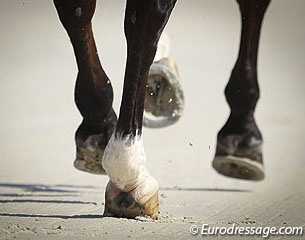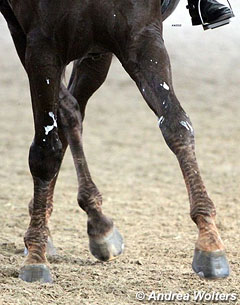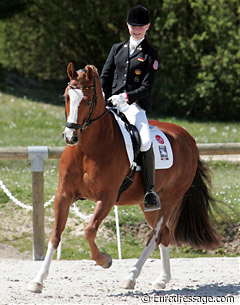
Nuno Oliveira used to constantly tell his pupils to "look for the rhythm" meaning focus on the rhythm. He did not tell them to speed up or to slow down as he knew it was up to the rider to feel the right rhythm and learn to control it. We read articles and dressage theories about how rhythm is fundamental to dressage training and the basis for everything else, but establishing this fundamental principle is deeply personal and, of course, extremely difficult.
It seems so easy: find the right rhythm and then stick to it, but, unfortunately, there is not a dressage-for-dummies-training-track that you can play while you are riding and simply match your horse to the beat. Rhythm is unique to every horse. It is determined by the horse’s strength, physique, character, relationship with the rider and confidence. It can be affected by everything around him, from the weather, to surface or rider imbalances as well as ill-fitting tack.
Finding the rhythm on a young horse is the most difficult because he is still finding his balance. It is up to the rider to find the optimum speed and length of stride that give him the setup to find his balance. On my young horse, if I go too slow, he feels like he achieves more swing in the back yet his hind legs begin to slow down and loose activity. Alternatively, if I go too fast, he loses the natural swing in the back and while he may be more active, he is not achieving the feeling that he is using his entire body with every stride. Thus the difficulty lies in creating the swing but maintaining the activity. If you can tick both boxes then concentrate, because that is the rhythm you should be trying to maintain in all your training.
 Often overlooked, the importance of establishing a clear rhythm at the beginning of each lesson does not start when you commence the trot. I have found that when I work the walk and really think about establishing those four clear even beats, that I have the foundation ready so when I begin the trot work, we are both already in the rhythmic frame of mind. Don't mosey on out into the arena and flop about in walk while your mind's off with the fairies, then suddenly expect to start the trot in a good tempo.
Often overlooked, the importance of establishing a clear rhythm at the beginning of each lesson does not start when you commence the trot. I have found that when I work the walk and really think about establishing those four clear even beats, that I have the foundation ready so when I begin the trot work, we are both already in the rhythmic frame of mind. Don't mosey on out into the arena and flop about in walk while your mind's off with the fairies, then suddenly expect to start the trot in a good tempo.
For riders working more advanced schoolmasters, they may be lucky to have a horse that already has a training track he plays in his head. However, young horses are especially tricky to find the right rhythm.
"Finding the right rhythm on a young horse is a question of tempo and every horse has a speed where they find their best balance. This speed normally lies somewhere between collected and working trot," said Jan Bemelmans. "As every horse has a unique morphology dependent on the horse's conformation, hind quarters, back, balance, contact, and temperament, so each horse has its own unique rhythm. When the horse is young, you should simply aim to ride low, long and with a forward tendency. This should not be difficult. The horse will then tell you when you have found the right rhythm by feeling good and you will notice that he will easily keep that rhythm and come into a light contact."
Stressing the importance of a good contact in relation to finding the right rhythm Jan also checks for a forward movement of the hind legs over the back, moving into the hand of the rider with an equal contact on both reins.
 Former Dutch team rider Gonnelien Rothenberger adds that usually every young horse has a rhythm by nature and it is up to us as riders to foster this natural speed. "You must concentrate to keep this natural rhythm and to never disturb it," said Gonnelien. "I feel the right rhythm of my horse when the footfalls stay constant. A sound dressage horse has three correct rhythms: a four-beat in walk, a two-beat in trot and a three-beat in canter.”
Former Dutch team rider Gonnelien Rothenberger adds that usually every young horse has a rhythm by nature and it is up to us as riders to foster this natural speed. "You must concentrate to keep this natural rhythm and to never disturb it," said Gonnelien. "I feel the right rhythm of my horse when the footfalls stay constant. A sound dressage horse has three correct rhythms: a four-beat in walk, a two-beat in trot and a three-beat in canter.”
Knowing that without rhythm a rider cannot educate a horse, Gonnelien has learnt that rhythm is more difficult with some horses than with others but that training can not progress without this vital component. “The greatest challenge I had with rhythm was with Konrad in the simply change of leg. He was always a horse who wanted to 'go,' and it was difficult for me to keep him relaxed and in the right rhythm in the walk steps between the canter. I slowly learned that, if I was able to control his tempo, he kept his rhythm in the walk."
Agreeing that the greatest sign of good rhythm is the rider's contact with the bit, Gonellien said that the rhythm can change as a horse matures simply because the horse will hopefully get more expression in his movement.
"It can be that the rhythm, especially in walk, can be better as the horse gets older because a rider can better control his tempo and he has learnt to accept the contact with the bit. The footfalls stay the same but the horse gets more expression (cadence) within the rhythm."
Text by Sarah Warne for Eurodressage
Photos © Astrid Appels - Andrea Wolters
Related Links
Classical Training: Walk the Walk
Sarah Warne's Classical Training Articles